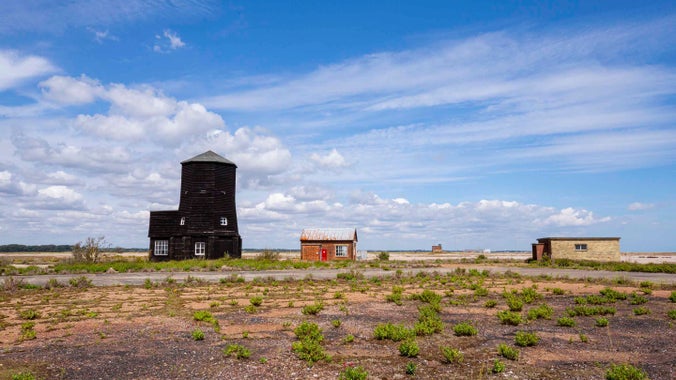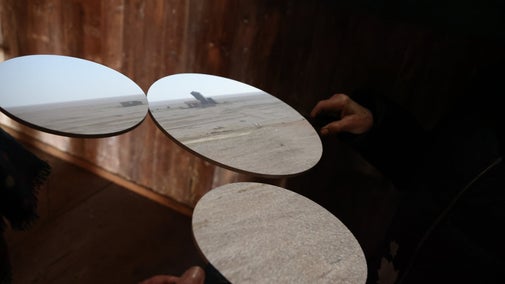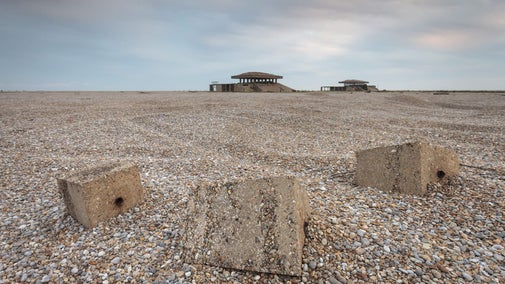
Become a member
Join today and help protect nature, beauty and history – for everyone, for ever. Enjoy access to more than 500 places with National Trust membership.
Internationally important coastal nature reserve, with a fascinating 20th-century military history
Quay Street, Orford, Suffolk, IP12 2NU

| Asset | Opening time |
|---|---|
| Nature reserve | Closed |
| Ticket type | With Gift Aid | Without Gift Aid |
|---|---|---|
| Adult (18+) | £4.50 | |
| Child (5-17) under 5s free | £2.25 | |
| Family (2 Adults and up to 3 children) | £11.25 | |
| 1 adult and up to 3 children | £6.75 |
| Ticket type | With Gift Aid | Without Gift Aid |
|---|---|---|
| Adult (18+) | £14.00 | |
| Child (5-17) under 5s free | £7.00 | |
| Family (2 Adults and up to 3 children) | £35.00 | |
| 1 adult and up to 3 children | £21.00 |
Due to ground nesting birds only Assistance dogs are allowed
Our second hand bookshop in Basecamp supports our work on Orford Ness.
Riverside Car Park (not National Trust) on Quay Street, 150 yards from Orford Quay. Pay and display - charge even for National Trust Members.
Regular guided tours covering different aspects of the site are available. Check our events section for details of booking.
Toilets are available on the Red Route opposite the Ranger Office and an accessible toilet is available within the Ranger Office.
Access via ferry and steep, sometimes slippery, steps. Accessible toilet available, assistance dogs only.
Once on Orford Ness the main routes are flat.
Toilets are available on the Red Route opposite the Ranger Office and an accessible toilet is available within the Ranger Office.
While there is no parking on Orford Quay itself, visitors can be dropped off Quayside before the car returns to the main Riverside car park.
Our Quay Office has an induction loop installed and there is a portable induction loop available on request for other buildings.
Apart from the river crossing, which requires negotiating steps, the majority of Orford Ness is level access. Two buildings have upper floors with stair access only but other buildings are ground level only.
Two manual wheelchairs and a self-drive Tramper mobility scooter. Available on a first come, first served basis. Free to use but donations welcome towards their upkeep. Advanced booking essential, please call 01394 450900.
There are a number of benches on site and seating in some of our buildings.
Crossing to Orford Ness involves a river crossing on our ferry. To board the ferry you will need to negotiate a number of steps which may be slippery due to the tide.
Two manual wheelchairs and a self-drive Tramper mobility scooter. Available on a first come, first served basis. Free to use but donations welcome towards their upkeep. Advanced booking essential, please call 01394 450900.
Orford Ness is now open for the 2025 visitor season. This page explains more about how you can book a place and what to expect on your visit.

Orford Ness has inspired everyone from bestselling writers to professional musicians.


See what events we have coming up at Orford Ness, from Island of Secrets walking tours to stargazing and astrophotography, each offering a chance to get to know this intriguing site better.

Discover the ways you can explore Orford Ness National Nature Reserve as a group, from guided walking tours to special interest visits, plus information about how to book.

We're passionate about making Orford Ness accessible to all needs and disabilities.

Start your visit on board as we ferry you across the River Ore via our ferry Octavia. Keep an eye out for wildlife including occasional harbour porpoises and seals. Don't forget to book your ticket in advance, space is limited.
Three walking trails (two open only seasonally) take you through coastal grazing marshes and out to the vegetated shingle. Home to numerous wetland and wading birds, Chinese water deer and hares.
One of the few sites in the UK with purpose-built facilities for the testing of components of nuclear weapons. Comprising of six 'labs', these buildings now form impressive backdrops on the shingle. Only Lab 1 is open to the public, the remainder have exterior access only on guided tours.
International rare and delicate landscape, consisting of shingle ridges and valleys, deposited over centuries by the sea. 20% of Europe's vegetated shingle is found on Orford Ness. Incredibly fragile, one single misplaced footstep can destroy structures that have taken centuries to form.
What was once a former World War One and World War Two Airfield, is now a rich grazing marsh, providing a home for birds and deer.
First World War building, adapted in the 1930s, for early work on Radar is now home to the Island of Secrets exhibition. The exhibition tells the story of 80 years of top secret research on 'the island'.
Built in 1933 as the centre of an experimental bombing range. The roof now provides a panoramic viewing platform giving stunning views across the entire site.
An unusual building, erected in 1928 to house an experimental rotating-loop navigation beacon. Now home to exhibition and views across the vegetated shingle.
Orford Ness has inspired everyone from bestselling writers to professional musicians.

Bring the whole family along for an adventure on Suffolk's secret coast.

Join our tour guide on a two-hour guided walk into the heart of the AWRE area, including the iconic 'Pagodas' and learn all about the history of these fascinating buildings.

Orford Ness has created over 10 miles of coastline and over 2,000 acres of land. Visit the rich and varied habitats on this internationally significant nature reserve.

Find out what you'll discover inside the many fascinating military buildings you'll see as you walk through Orford Ness.

From honouring the people who worked here to managing the landscape, discover what goes on behind the scenes to preserve Orford Ness for visitors and wildlife alike.

Detailed trails will be coming to the website very soon. Until then, please speak to the team when you visit, who'll be able to share the routes available.

Sorry, there are no upcoming events at this place
Take a short boat trip to this wild and remote shingle spit, the largest in Europe.
Follow walking trails through a stunning landscape and a history that will both delight and intrigue.
Discover an internationally important nature reserve littered with debris and unusual, often forbidding, buildings from a sometimes disturbing past.
Please note: Access is only via the National Trust ferry Octavia from Orford Ness. There is no access on foot or by vehicle via Slaughden. There is a charge for ferry to Orford Ness (including members). Tickets are limited and must be booked in advance. No bikes or dogs (assistance dogs welcome) allowed.
From a military testing site to an internationally significant nature reserve, discover the history of Orford Ness from the 16th century to the present day.

The first grey seal pup of this winter has been born at Orford Ness in Suffolk, marking the fourth consecutive year of successful breeding at the coastal site.

A rare species of jumping spider has been identified at Orford Ness in Suffolk.

National Trust rangers at Orford Ness National Nature Reserve in Suffolk are celebrating the birth of over 130 grey seal pups this winter; the third, consecutive year of successful breeding at the coastal site, which is now thought to be home to Suffolk’s first grey seal colony.

From honouring the people who worked here to managing the landscape, discover what goes on behind the scenes to preserve Orford Ness for visitors and wildlife alike.

If you have some time to spare and want to help us to keep Orford Ness safe and secure for visitors and wildlife, why not join us as a volunteer? Find out how you can join the team.


Join today and help protect nature, beauty and history – for everyone, for ever. Enjoy access to more than 500 places with National Trust membership.
By sharing your email address you’re agreeing to receive marketing emails from the National Trust and confirm you’re 18 years old or over. Please see our for more information on how we look after your personal data.